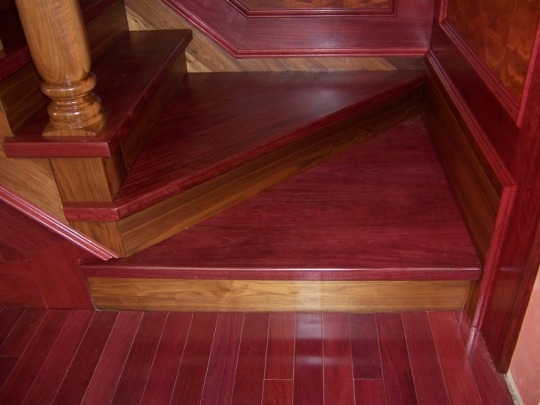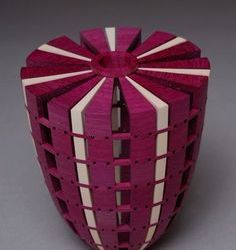#i made a cutting board in middle school woodshop and we were able to pick out a couple of different woods to glue together for the board
Explore tagged Tumblr posts
Text
It's a gorgeous wood, but it's also indigenous to the Amazon and demand for it contributes to the continued destruction of the Amazon Rainforest. It is not sustainable nor eco-friendly in terms of obtaining it (outside of the destruction of the Amazon, the amount of transportation it takes to bring to the U.S. adds a decent carbon footprint to the table). [source]
Just got to do some woodworking for the first time in a long while, and I am once again reminded of why I enjoy my favorite type of word to work with: Purpleheart.
Why’s it called purpleheart?

Muthafuckin’ purple wood. How cool is that? It’s brown when you cut it, but due to oxidization, eventually turns to a beautiful purple color. (if you don’t seal it at this stage, it’ll eventually turn red, I believe, which is still pretty, but you buy purpleheart for purple, damnit!)
And everything you make with it turns out amazing.
Purple floors?

Nice.
Purple stairs?

Fancy.
Purple table?

Sweet.
Purple guitar?

Awesome.
Purple whatever the hell is going on here?

Epic.
It’s just such a cool wood to work with, and it’s sturdy enough to be used for just about anything. If I ever get a house, half of it might just end up being made out of purpleheart.
Anyway, that’s enough nerdery for one post. I will now return to reblogging stupid pictures and recipes.
#i made a cutting board in middle school woodshop and we were able to pick out a couple of different woods to glue together for the board#and one of the choices was purpleheart#but our instructor limited us to one piece per person if we wanted one because of its increasing rarity#i picked one of each specialty wood (purpleheart‚ walnut‚ and cherry) and i think the blend of colors looks really nice#purpleheart is gorgeous but these example pictures are horrendous to think about with how exploited indigenous forests are#dyed/stained woods are a much better alternative
138K notes
·
View notes
Text
Reopening with Closing Remarks
Hi blog friends, last I check in with you, I promised to post my closing remarks from Manchester Community College’s Girls in Technology day. If anyone new here is tuning it, this is my story in engineering and how I ended up where I am now.
Unfortunately, reading this won’t be as good as hearing it...so I guess now you just have to come to Northeastern and take one of my tours to get the next best thing. Read my speech under the cut!
My name is Deirdre and I’m a third year student at Northeastern University studying bioengineering and computer science and I’m currently working at Farm Design, which you heard a little bit about earlier. But you heard me right, I’m a student. I’m not some crazy accomplished engineer, scientist, or CEO. I’m still learning and I’m still making mistakes, so I wanted to talk to you here today student to student. I want to share my experiences.
How did I end up here? Up until high school I was absolutely convinced I wanted to be a pediatrician- heck, I couldn’t even spell pediatrician back then. I was arm twisted out of taking Latin by my woodshop teacher, and I found myself in Intro to Engineering Design instead through a program called Project Lead the Way.
One day I was sketching in my notebook a *real* engineer came up to me, excited about my sketches, and asked if I was interested in studying engineering. Here’s the thing, if you’ve ever had someone you think is cool ask you a question, you don’t want to disappoint them. So I stuttered out, “YES! Bio engineering!”. No lie, I thought I made up this engineering discipline on the spot, but this engineer seemed pleased with my answer and moved on.
It turns out that bioengineering is very real and now I’m in the first graduating class of the major at Northeastern University. So what actually is bioengineering? Bioengineering is a lot of things, bioengineering is modifying cell protein receptors to enhance drug delivery, it’s creating medical devices to make processes more efficient and safe, and it’s reading signals sent from the body to help us understand the many unknowns in our brain. In short, bioengineering is anything that involves an engineering and problem solving practice that interfaces with an organic living body. Many other disciplines can go into bioengineering fields without being bioengineers, it’s all about what blade you really want to sharpen.
In my journey, I became fascinated by the world of prosthetics and how the human body interacts with the world around us.
I’m a musician, and maybe some of you are too. Can you imagine playing your instrument with only one hand? Can you imagine playing soccer with only one leg, or can you imagine living your normal day to day life without part of your body? I’m beginning to imagine as I learn more about the advancements in the industry, and I want to make this “imagination” dream into a reality for millions.
But let’s step back a second, because this makes me sound like I have my life together. Maybe you don’t know what you want to do with your life yet. That’s okay, most people don’t. Did you know the most popular major for incoming students at Northeastern is “undeclared”. Everyone is different, and everyone will have a different journey as you find out what you like. Maybe you’re like me and you have some clear goals for the future, but it wasn’t always like that. One time I was presenting about engineering at my former middle school and I asked the kids if anyone knew what they wanted to be and one kid in the front of the room raised his hand and was like “I want to be a journalist but I know that’s nor a profitable field, so I’m also considering going into a science field”.
Excuse me.
This kid had his life more together than I did. In case anyone’s curious, he’s now in college studying theater so?
I also want to say that a lot of this whole growing up thing is not about what you studied and where. I’ve learned that it’s about your experiences, those are the things that will set you apart. So go to a school that works for you and feels right. My old AP Econ teacher used to tell us to throw a dart at a board to pick a college because it’s also hard to know what you want until you get there. Degrees and nice titles have been said to be able to open doors, but I believe with the right tool set from experience, you can just pick the lock.
In building your repertoire of experiences, don’t be afraid to try new things or give things a second shot. I’m a really sore loser to the point where I refused to play games or sports because it gave me the possibility to lose. When I got to college, the friends I made happened to be super into board games. Well, that’s just *perfect*. After months of them pestering me to join, I decided my friendship with them took priority over my dislike of losing. Well, I lost in the first game I ever played with them and I continue to lose most times we play, but the weird thing is…I had fun? Later that year, we founded Northeastern’s first Board Game Club. Needless to say, my parents were shocked, but I was proud.
Take advantage of any and all opportunities to discover and learn. You’re here now, and that’s a fabulous first step! Maybe from this event you’ve realized you are hooked on STEM, maybe you’ve realized this isn’t for you, and maybe you’re indifferent. The point is, you did it. At Northeastern, we have this program called co-op which allows me to take these 6 month internships 2-3 times within my academic schedule. Co-op for me is less about building a resume, but instead discovering what I like and don’t like. It’s a chance to make mistakes before you enter the *real* world, you still have the crash pad that is college. You can change your mind, tweak your path, or dive deeper into your passions.
For me, I quickly discovered that I loved computer science and wanted to integrate that into what I did. I took my first coop in robotics/comp sci at Corindus Vascular Robotics and learned so much about the back end of software development, diving into the nitty gritty of what actually tells these systems what to do. Since college, I learned about a super cool field called biomimicry through one of the research labs on campus. Biomimicry is essentially the replication of a living system or functions of a living system; nature has spent years perfecting design, so why not save those millions of years of work? I currently do research at Northeastern’s marine science center, designing, and testing biomimetic robotic lobsters. It turns out all lobsters can smell nitrous oxide, and all bombs let off nitrous oxide. But apparently it’s inhumane to send an army of lobsters under water to search for bombs, and even if we could do that, how would they relay the information? At my lab, we are building lobsters that can see, smell, and think for themselves that will interact with the environment the same as a real lobster. How cool is that? Learning about this field got me super curious about what other hidden engineering functions nature has designed for us, so this summer I am heading off to Oxford, UK, for 5 weeks to study engineering design in nature.
I once had a professor in college that asked, “Deirdre, what makes you happy?” I told him making people laugh, building things, and seeing people benefit from my hard work.
Then he asked, “Why? What about those things make you happy?” I still don’t know how to explain the feelings and emotions that bring me joy from these things. So I want to ask all of you, what makes you happy? Figure out your answer, and whether or not you can answer the why, hold those things dear. I actually think the harder it is to answer “why”, the stronger the feeling is. You can actually use those little things to make a life and a career.
So I leave you with this:
Do not fear failure, stay curious, be innovative, be patient, create, make, but most importantly, be you. Be part of the 17% but also be part of the 100% to make this world one that makes you happy.
#nu husky blog#dee tour#engineering#northeastern#northeastern university#college advice#mcc#machester community college#girls in technology
1 note
·
View note